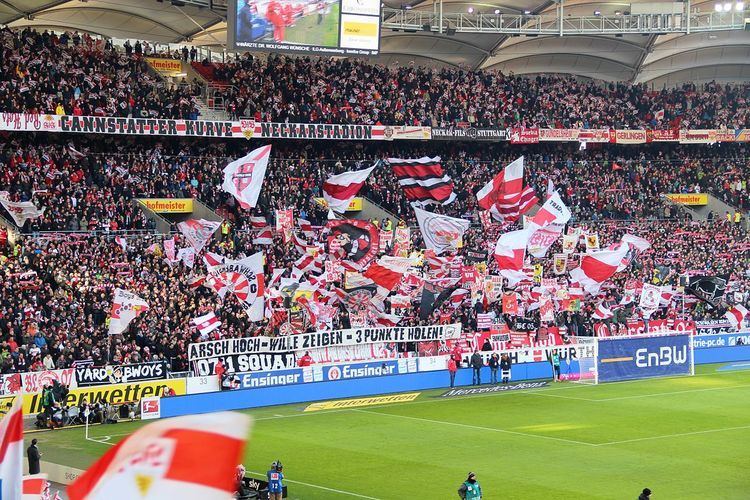Location Stuttgart, Germany Opened 23 July 1933 Team VfB Stuttgart | Surface natural grass Owner Stadion NeckarPark | |
 | ||
Former names Adolf-Hitler-Kampfbahn (1933–1945)
Century Stadium (1945–1949)
Neckarstadion (1949–1993)
Gottlieb-Daimler-Stadion (1993–2008) Operator VfB Stuttgart Arena Betriebs GmbH Capacity 60,469 (League Matches),
54,906 (International Matches) Record attendance 97,553 (Germany-Switzerland, 22 November 1950) Address Mercedesstraße 87, 70372 Stuttgart, Germany Architects Paul Bonatz, Friedrich Eugen Scholer Profiles | ||
The Mercedes-Benz Arena ( [mɛʁˌtseːdəsˈbɛnts ʔaˌʁeːnaː]) is a stadium located in Stuttgart, Baden-Württemberg, Germany and home to German Bundesliga club VfB Stuttgart.
Contents
- History
- International matches
- Trivia
- Sports other than football
- Redevelopment
- International tournaments matches
- 1974 FIFA World Cup
- UEFA Euro 1988
- 2006 FIFA World Cup
- Concerts
- References
Before 1993 it was called Neckarstadion [ˈnɛkaɐ̯ˌʃtaːdi̯ɔn], named after the nearby river Neckar and between 1993 and July 2008 it was called Gottlieb-Daimler-Stadion [ˌɡɔtliːpˈdaɪmlɐˌʃtaːdi̯ɔn]. From the 2008–09 season, the stadium was renamed the Mercedes-Benz Arena, starting with a pre-season friendly against Arsenal on 30 July 2008.
History
The stadium was originally built in 1933 after designs by German architect Paul Bonatz. After It was built, it was named "Adolf-Hitler-Kampfbahn". From 1945 to 1949 it was called Century Stadium and later Kampfbahn and was used by US Troops to play baseball.The name Neckarstadion was used since 1949. It is home to VfB Stuttgart in the Bundesliga (and to the Stuttgarter Kickers when they played in the Bundesliga ).
After a major refurbishment in the late 1980s and early 1990s partly financed by Daimler-Benz, the Stuttgart town council dedicated the stadium to Gottlieb Daimler. The inventor had tested both the first internal combustion motorcycle and the first 4-wheel automobile there in the 1880s, on the road from Cannstatt to Untertürkheim (now called Mercedesstraße). The new museum, the headquarters and a factory of Mercedes-Benz are nearby.
The stadium capacity is currently around 41,000, after one stand (Untertürkheimer Kurve) has been demolished during summer 2009 in the process of converting it to a pure football arena. The rebuilt arena will be finished in December 2011 with a new capacity of 60,000, including terracing. Due to UEFA regulations, which only allows seating, the capacity is reduced to 54,906 during international football matches.
It is divided into four sections,
The Mercedes-Benz Arena features a unique fabric roof construction, making it easily recognizable. Made of precision-tailored membranes of PVC-coated polyester, the roof tissue is durable enough to withstand 1,000 kg of weight per square decimeter. It is suspended from an aesthetic steel frame that runs around the entire stadium weighing approximately 2,700 metric tons. The steel cables connecting the roof to the frame alone weigh about 420 tons. The roof wasn't added until the refurbishment preceding the 1993 World Athletics Championships.
International matches
The Mercedes-Benz Arena hosted four matches of the 1974 FIFA World Cup, two matches of the 1988 UEFA European Football Championship (a 1st Round match and a semi-final) and six games of the 2006 FIFA World Cup, including a Round of 16 game and the third-place playoff match (see below for details).
The stadium also hosted the finals of the European Cup (now known as UEFA Champions League) in 1959 (Real Madrid vs. Stade de Reims) and 1988 (PSV Eindhoven vs. S.L. Benfica).
Trivia
Sports other than football
The 1986 European Athletics Championships in which the hammer throw world record by Yuriy Sedykh was set, and the 1993 World Athletics Championships were held there, and the Daimler-Stadium was the host the IAAF World Athletics final from 2006 to 2008. The arena has also been the venue of several Eurobowl finals of American Football in the 1990s. The last athletics event took place in September 2008, after which the stadium undergoes redevelopment in order to build a football-only arena.
Redevelopment
Starting in 2009, the Mercedes-Benz Arena will be redeveloped into a football-only stadium. It is planned that new stands will be constructed by the summer of 2011, with pitch level being lowered by 1.30 metres in time for the beginning of the 2009–2010 season. Once all the interior redevelopment is finished, the roof will be expanded to cover new rows of seats. The entire construction is expected to be finished by the end of 2011. The redevelopment was announced along with the stadium's name change in late March 2008. The first computer images of the new arena were released at the same time, also showing a large cube with four video scoreboards above the centre circle, similar to the one in the Commerzbank-Arena in Frankfurt.
Within the first couple of weeks of the redevelopment, 18 undetonated bombs left over from the air raids on Stuttgart during the Second World War were found on the construction site.
International tournaments matches
All times local (CET)
1974 FIFA World Cup
Stuttgart hosted the following matches at the 1974 FIFA World Cup:
UEFA Euro 1988
These UEFA Euro 1988 matches were played in Stuttgart:
2006 FIFA World Cup
The following games were played at the stadium during the 2006 FIFA World Cup:
Concerts
Depeche Mode performed at the stadium on 3 June 2013 during their Delta Machine Tour, in front of a sold out crowd of 36,225 people.
